| Article ID | Journal | Published Year | Pages | File Type |
|---|---|---|---|---|
| 8513450 | Journal of Pharmaceutical Sciences | 2018 | 9 Pages |
Abstract
Protein oxidation is a major pathway for degradation of biologic drug products. Past literature reports have suggested that 2,2-azobis (2-amidinopropane) dihydrochloride (AAPH), a free radical generator that produces alkoxyl and alkyl peroxyl radicals, is a useful model reagent stress for assessing the oxidative susceptibility of proteins. Here, we expand the applications of the AAPH model by pairing it with a rapid peptide map method to enable site-specific studies of oxidative susceptibility of monoclonal antibodies and their derivatives for comparison between formats, the evaluation of formulation components, and comparisons across the stress models. Comparing the free radical-induced oxidation model by AAPH with a light-induced oxidation model suggests that light-sensitive residues represent a subset of AAPH-sensitive residues and therefore AAPH can be used as a preliminary screen to highlight molecules that need further assessment by light models. In sum, these studies demonstrate that AAPH stress can be used in multiple ways to evaluate labile residues and oxidation sensitivity as it pertains to developability and manufacturability.
Keywords
Related Topics
Health Sciences
Pharmacology, Toxicology and Pharmaceutical Science
Drug Discovery
Authors
Michelle Z. Dion, Y. John Wang, Daniel Bregante, Wayman Chan, Nisana Andersen, Amy Hilderbrand, Danielle Leiske, Cleo M. Salisbury,
